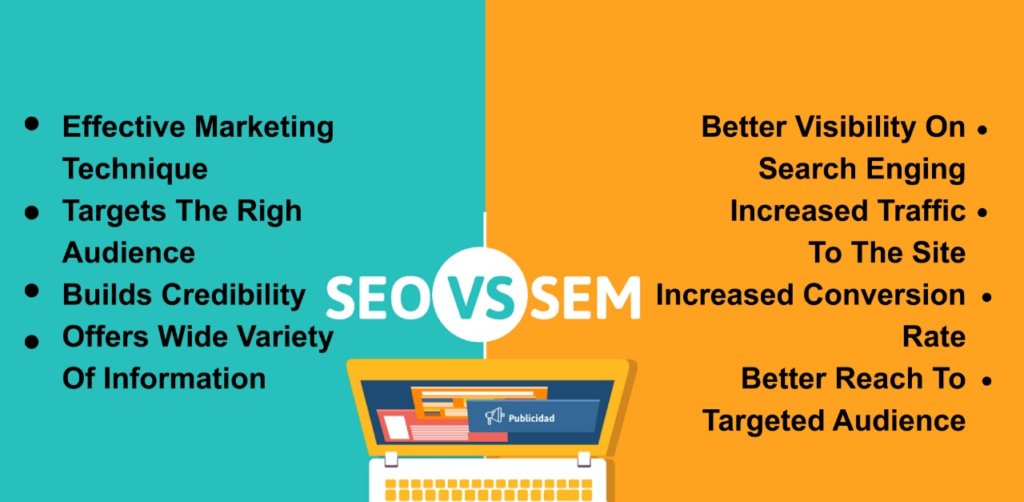What’s the Difference Between SEM and SEO?
Search engine optimization (SEO) and search engine marketing (SEM) are two vital concepts in the world of digital marketing. Though both aim to drive traffic to a website from search engines, there are significant differences between the two.
In this article, we’ll discuss the main difference between SEM and SEO, what the strategies are for each, and how they complement each other.

The primary difference between SEM and SEO is that SEO refers to the organic branch, while SEM refers to the paid branch. SEO involves optimizing a website and its content to rank higher in search engine results pages (SERPs) organically. SEM, on the other hand, involves using paid advertising to increase visibility in search engine results pages. The difference between SEM and SEO is that SEM provides an immediate impact while SEO takes more time to yield results.
Below we will take a more comprehensive look at the difference between SEM and SEO strategies.
SEO Strategies
SEO strategies involve optimizing website content to improve its ranking in search engine results. This process includes researching relevant keywords and phrases, creating high-quality content, optimizing metadata including page titles and descriptions, and earning links from authoritative websites, all of which boost a website’s rank.
SEO strategies could also include optimizing a site’s design and structure, usability, mobile-friendliness, and overall site speed. The goal of any SEO strategy is to align a website’s content with search engine algorithms to rank higher for target search queries.
As mentioned above, these strategies take more time to yield results, but they can also ensure stronger, long-term success when done correctly. By organically positioning your website as a source of quality and authoritative content, the chances of people coming back to it are much higher.
SEM Strategies
SEM strategies, on the other hand, involve paying for targeted traffic by creating and running online ads in search engines. SEM strategies include implementing keywords into ad targeting, creating engaging ad copy, designing visually appealing ads, optimizing landing pages, and measuring success with tracking analytics.
Utilizing SEM gives your business an instant boost in visibility in search engine results and allows you to see immediate results while you work on building organic traffic. This strategy allows businesses to stay competitive by increasing visibility and driving traffic to their websites, irrespective of whether they are just starting or are established in their target market.
With SEM, advertisers only pay when a user clicks on the ad, which means it is important to create well-targeted, persuasive ads that lead to high-converting landing pages.
How SEO and SEM Strategies Complement Each Other
Despite the difference between SEM and SEO, their strategies complement each other. For instance, using SEM can help boost the visibility of a website on search engines after it has been newly launched or when it is going through an SEO optimization process. This can be helpful for businesses that are just starting out or those that need quick results. Similarly, using SEO can help improve the quality score of a website, which in turn reduces the cost of paid advertising, making SEM more affordable.
Another way in which SEO and SEM complement each other is that they are both based on keyword research and analysis. Keyword research is a crucial aspect of both SEO and SEM, and it involves identifying keywords and phrases that are relevant to the business, its products, and its target audience. The data collected from keyword research and analysis can also be used to inform copywriting and content creation strategies for both organic and paid search campaigns.
Furthermore, with the difference between SEM and SEO, SEO and SEM can help businesses target different stages of the buyer’s journey. For example, SEO can be used to create informational content that educates users about the products or services offered by a business. This can help to raise brand awareness and draw potential customers to the website. On the other hand, SEM can be used to target users who are at the consideration or purchase phase of the buying journey. In this case, businesses can use paid search ads to promote specific products or services and drive sales.
While SEO and SEM strategies have different goals, they both rely on measurement and data analysis to optimize their campaigns. When it comes to SEO, measuring the success of the campaign involves monitoring metrics such as page rankings, click-through rates, bounce rates, and time on site. SEM campaigns, on the other hand, require analyzing metrics such as click-through rates, conversion rates, cost-per-click, and return on investment, among others. By analyzing these metrics, businesses can optimize their campaigns and allocate their marketing budgets more effectively.
Conclusion
The difference between SEM and SEO is significant, but they are not mutually exclusive. Both strategies can be used to increase visibility, drive traffic, and ultimately, achieve business objectives. Businesses that effectively combine these two strategies can optimize their online presence and achieve faster results by targeting different stages of the buyer’s journey.
When used together, SEO and SEM strategies can create a powerful toolset for businesses to increase their online visibility and boost their competitive edge. However, it is important to have a well-planned and well-executed strategy for both SEO and SEM for a successful digital marketing campaign.
Here at WriterArmy, we offer a series of premium SEO services at cost-effective prices, including local SEO, national SEO, and global SEO. Contact us for a free SEO audit, we would love to hear from you!








